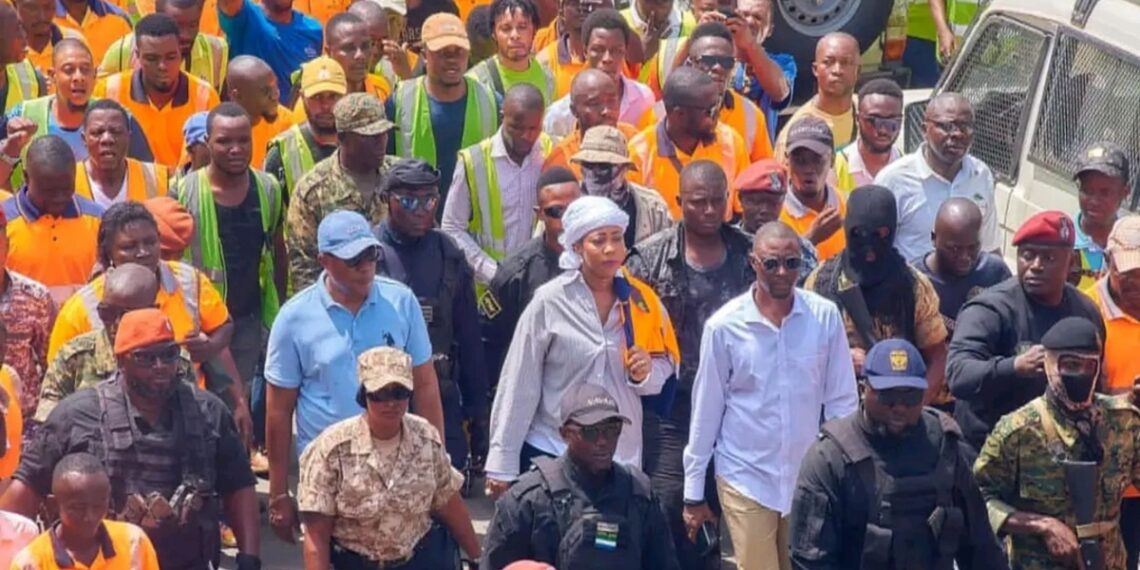
When Her Excellency Mrs Fatima Bio spearheaded and joined a strike action by workers from Koidu Limited Mining Company (KLMC), her detractors wasted no time in condemning her action, as attention seeking or misuse of her privileged position as the First Lady. Irrespective of her position as First lady, those who know Fatima Bio believe that she did so as a citizen and daughter of the soil. As for those who don’t know, Fatima grew up on the foothills of the very hills that are being blasted daily by the mining company. Fatima grew up around the Koquima and Boroma environs of Sefadu. As usual, Fatima’s detractors never fail to display their penchant and propensity to oppose everything and anything Fatima Bio. But for those who grew in the shadows of several mining companies like Sierra Leone Selection Trust (SLST) and National Diamond Mining Company (NDMC) in the past, what’s happening under the ownership of KLMC is a painful reminder of how one can sit by the river and still wash your hands with spittle.
Mrs Bio made it clear that she “joined my brothers and sisters working at the Koidu Limited Mining Company in Koidu City to peacefully protest. Our collective action aimed to urge Koidu Limited to enhance working conditions and provide better services for all employees.”. She stressed that her aim was not to create or nurture grudges or discord in the community, but to seek enhancement of the conditions of service for the employees and advocate for fair labour practices as part of Koidu Mining’s corporate responsibility. In short, she just wanted a commensurate recognition of the vital role the workers play in Sierra Leone’ economy. The workers’ key demands include “a formal recognition of their union, living allowances, and a request for 30% salary increment, overtime compensation, the provision of incentives (bonuses), and access to safe drinking water and freedom of financial choice”
A history of Mining companies in Kono.
The first diamond was discovered in Futingaya, a small village on the outskirts of Sefadu, Kono District in 1930, and the same year that Kentucky Fried Chicken (KFC) was invented. This discovery led to the founding of the Sierra Leone Selection Trust (SLST) that had sole control of diamond mining in the district and beyond. It led to offshoots of other related companies like Diamond Corporation of West Africa (DICOWAF), which supervised the processing and exporting of the diamonds. With other companies like DELCO (Marampa Mines) and Rutile Mining Company alongside manufacturing industries including Sierra Fisheries, Sierra Leone Produce Marketing Board, Aureol Tobacco Company, Magbash Sugar Factory, etc., it was easy to see why our country was fondly called “SWEET SALONE”.
On average, at least one family member of every household in Kono was employed by SLST and later NDMC as not only one of the largest but regarded as the best employers and the place to be. In those days, the benefits which included residential quarters, discounted supermarkets products, sports, medical, educational, social etc. facilities were European standard. Students whose parents were employed by these companies were considered royalty. Areas like Clerks’ quarters, Ducane club, Leopard Hill, housing for A, B and C staff reflected some sense of care and corporate responsibility in the community. Yengema, the District headquarter of NDMC was paradise on earth.
From a national standpoint, it was Sierra Leone’s main Cash Cow, a time when the British Pound was exchanged for 60 Sierra Leone Cents, and the Leone could be exchanged on arrival in England. This is not fantasy. That is how Sweet Salone was. Unfortunately, the late Siaka Stevens privatised NDMC, handed it over to his partner in crime, Jamil S. Sahid and the rest is history. Factor the unwise and recalcitrant decision to host the OAU against all economic sanity, you begin to feel the death knell of our current economic malaise; a concomitant effect that has degenerated into pervasive corruption.
How did we get here today?
As the reserves of alluvial diamond deposits diminished, so the need for deep mining became imperative. This meant that most of the mining operations like kimberlite mining required high use of explosives. The risks and impact of such exercise is obvious to all. In Kono today, many residents are complaining of subsidence, as the foundations of their homes are shaken to the core because of the blasts from the explosives. Notwithstanding the infrastructural damages, in spite of the risks from flying debris and materials to people and property, there have been several reports of earth tremors in the area. This has never been rated as “breaking news” because no lives have been reported lost……so far. So, what would happen twenty to thirty years down the line when the miners would have long gone? So, before you condemn Fatima Bio for raising concerns about the goings on in the area, just remember that she grew up on the footsteps and foothills of those same hills in Koquima and Boroma.
Has Diamond Mining been a curse or blessing to Kono District?
Let us look at some facts here. Diamond exports, like the iron ore were prime cash cows for the economy. Thanks to Chief Mbriwa’s carpet crossing in the 1967 elections, which tilted the results to APC, the late Pa Siaka rewarded Kono District abundantly with a lot of cabinet and ministerial positions in his government for many years. It is very easy to take refuge in the destruction during the rebel war but prior to 1991, can any one point to any lasting and sustainable development, project or infrastructure as a legacy of the bounty from diamond mining in Kono? Where were the 6th forms, colleges, universities etc.? Instead of being a blessing, diamonds and “blood diamonds” in effect became the attraction for the rebel war. What has Kono got to show for its blessed earth? Have you tried visiting Yengema town lately? You would be hard pressed to recall that it was the heartbeat of the mining operations for SLST and NDMC.
If you are looking for an example of where time stood still, try Ngaya, Clerks’ Quarter, Motema, Leopard Hill, etc. While other towns and environs have slowly regenerated, you would be forgiven to think that Yengema and its surroundings are a UNESCO world heritage site. In places like Tefeya, Yomandu, Tombodu, Nimkoro, Sewafe, and many other towns and villages, diamond mining was the main stay. But unlike Yengema and its environs, these towns and villages had agriculture as a back-up or fail safe. With diminishing diamond reserves, Yengema has been left up the creek without a paddle. Is it surprising that the impact is more visible in Yengema?
So, to those who feel that Mrs Bio is an attention seeker, is abusing her position as First lady or trying to stir up unrest, think again. When our ancestors travelled all the way from Mande and through the Fouta Djallon mountains, they looked for a place to rest. What they sat on was hills and mountains of wealth. Sadly, some people came around, told them to get up and they swept the wealth right from under their bottoms. I still remember those days when after a heavy downpour of rain overnight, people used to walk under the eaves and picked diamonds in the morning. Some of us feel much betrayed. Kono district is the proverbial man that sits by the river and washes his hands with spittle.

So, those who condemn Fatima Bio should ask themselves:
What happens when the houses start falling due to subsidence?
What happens when the mining companies leave eventually?
What happens to the already damaged eco-system?
What would be the legacy in life after diamonds?
Who would reclaim all those mosquito infested artificial lakes and ponds in the area?
Leave Fatima alone.
Eid Mubarak.
May the last man please turn the light off?


Be the first to comment